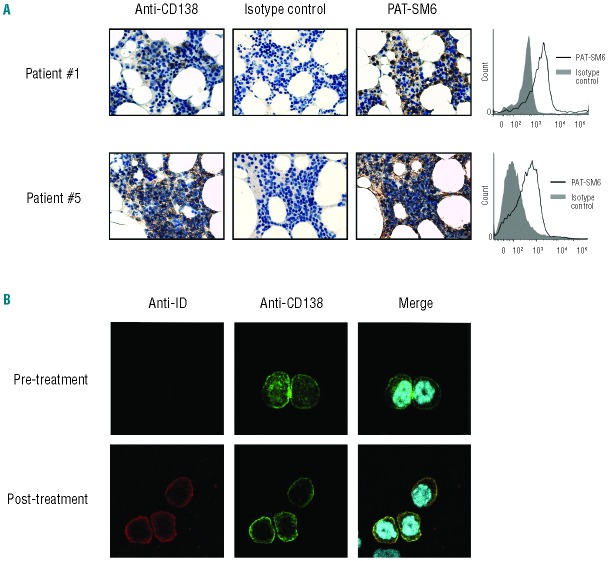Abstract
The primary objective of this phase 1 study was to evaluate the safety and tolerability of the anti-glucose regulated protein 78 monoclonal immunoglobulin M antibody PAT-SM6 in subjects with relapsed or refractory multiple myeloma. Twelve heavily pretreated patients received four intravenous infusions of PAT-SM6 at doses of 0.3, 1, 3, and 6 mg/kg within 2 weeks. Efficacy, pharmacokinetics and immunogenicity were followed up until the end of the trial (day 36). In addition, immune cell patterns in peripheral blood were assessed by flow cytometry and glucose regulated protein 78 expression status was evaluated in bone marrow specimens by immunohistochemistry and flow cytometry at screening. All doses administered were found to be safe and well tolerated; the maximum tolerated dose was not reached. The most common treatment emergent adverse event was leukopenia (grades 1 and 2) in eight out of the 12 multiple myeloma patients. Pharmacokinetic analysis demonstrated dose-proportional increases in drug serum concentration. The terminal half-life ranged from 5.86 to 8.41 h, the apparent volume of distribution ranged from 101 to 150 mL/kg, and clearance ranged from 8.11 to 16.1 mL/h/kg. All patients showed glucose regulated protein 78 surface expression on multiple myeloma cells. Four out of the 12 patients (33.3 %) had stable disease, according to the International Myeloma Working Group criteria, after PAT-SM6 treatment across the doses 1, 3 and 6 mg/kg. In summary, single-agent PAT-SM6 was well tolerated with modest clinical activity in relapsed or refractory multiple myeloma. Further trials exploring the combination of PAT-SM6 with existing myeloma therapies are planned. Trial registration: clinicaltrials.gov identifier: NCT01727778
Introduction
Multiple myeloma (MM) remains largely incurable despite high-dose chemotherapy with autologous stem cell transplantation and novel treatments with different immunomodulatory drugs and proteasome inhibitors. Patients eventually become resistant to all novel agents and subsequently succumb to the disease. There is, therefore, an unmet medical need to develop new treatment modalities for patients with relapsed and refractory MM.
Although effective in other lymphoid malignancies, immunotherapy with monoclonal antibodies has been largely unsuccessful in the treatment of MM. However, the situation is now changing and various antibodies with proven activity as single agents or in combination with other drugs are emerging as therapies in MM. In the past 10 years, more than ten therapeutic antibodies for the treatment of MM have been evaluated in clinical trials and many more are currently at different stages of preclinical development.1,2 At present, novel candidates, including elotuzumab (anti-CS-1), daratumumab (anti-CD38) and lucatumumab (anti-CD40), are being explored in phase 1–3 trials, with promising results in phase 1/2 trials, although their success remains to be established.3–7
PAT-SM6, a fully human immunoglobulin type M (IgM) antibody, targets a cancer-specific isoform of a normal cellular protein, glucose regulated protein 78 (GRP78).8,9 In normal cells, GRP78 is a major endoplasmic reticulum chaperone that facilitates protein assembly and regulates endoplasmic reticulum stress signaling. In malignant cells, it has been shown that isoforms of GRP78 can exist outside the endoplasmic reticulum, in the mitochondria, the cytosol and on the cell surface. GRP78 is a potent anti-apoptotic protein that plays a crucial role in tumor progression and angiogenesis, metastasis and resistance to chemotherapeutics including proteasome and BRAF inhibitors.10–14 Increased expression levels of GRP78 in cancer cells have been correlated with an adverse prognosis and drug resistance in various cancers including breast, ovarian, lung, gastric and prostate malignancies.12,15,16 The expression of GRP78 on the surface of cancer cells, but not normal cells in vivo, presents a paradigm shift on how GRP78 controls cell homeostasis and provides an opportunity for cancer-specific targeting.
We have previously demonstrated that PAT-SM6 targets a novel isoform of GRP78 that is expressed on the surface of a majority of primary MM specimens and cell lines tested with no significant reaction to primary non-malignant hematopoietic tissue including normal plasma cells.17 PAT-SM6 treatment of MM cells leads to significant cytotoxic effects through induction of apoptosis as the main mode of action and activation of complement-dependent cytotoxicity as a second killing mechanism. Furthermore, GRP78 is an interesting target in MM due to its sensor function in the unfolded protein response pathway.13,18
PAT-SM6 has been further investigated in various cancer animal models and has been shown to induce significant reductions in metastasis and/or tumor size and volume.19,20 In formal toxicology evaluations, PAT-SM6 showed no adverse effects up to repeated doses of 50 mg/kg in cynomolgus monkey studies. PAT-SM6 appears to be safe and well tolerated and demonstrated encouraging preliminary anti-tumor activity when used at low doses in patients with recurrent ‘in-transit’ cutaneous melanoma.20
Based on these promising preclinical observations, the clinical study of PAT-SM6 in MM was initiated.
Methods
Patients
Adult patients with relapsed and/or refractory MM who had received at least two previous lines of treatment including an immunomodulatory agent (thalidomide or lenalidomide) and a proteasome inhibitor and were showing progressive disease, as defined by the International Myeloma Working Group (IMWG) criteria21 were included.
Patients had Eastern Cooperative Oncology Group (ECOG) performance status grade 0–2 at study entry, an absolute neutrophil count ≥1000/mm3, a platelet count ≥30×109/L, hemoglobin level >8 g/dL and adequate renal function, with a calculated creatinine clearance (using the Cockcroft-Gault formula) of >30 mL/min.
Study design and treatment
This study was approved by the Paul-Ehrlich Institute and the local ethics committee of the University of Würzburg and conducted in accordance with the Declaration of Helsinki.
The primary study objective was to assess the safety and tolerability of escalating doses of the anti-GRP78 monoclonal antibody PAT-SM6 in subjects with relapsed or refractory MM. The secondary objectives were to evaluate the efficacy and pharmacodynamics, exploratory biomarkers and anti-PAT-SM6 antibodies. The study also aimed to evaluate the duration of response and progression-free survival.
PAT-SM6 was administered intravenously over 90 min. Patients in four dose cohorts (0.3, 1, 3 and 6 mg/kg) were treated on days 1, 3, 8 and 10 (Figure 1). Due to limited amount of antibody product available, the study was designed as a small pilot trial of four increasing doses rather than an open trial with ongoing dose escalation and treatment of patients until progression. Patients received pre-medication with antihistaminic drugs. Prior to each dose escalation, the DSMB met to review the tolerability and toxicity in the previous dose group.
Figure 1.
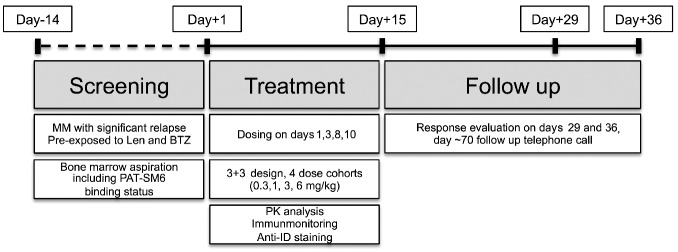
Study design. Len: lenalidomide; BTZ: bortezomib; anti-ID: anti-idiotype antibody specific for PAT-SM6. PK: pharmacokinetic.
A screening examination was performed within 14 days prior to dosing and subjects returned for outpatient evaluations on days 15, 22, 29 and 36 for safety and response and for pharmacodynamic assessments.
Criteria for evaluation
Safety parameters were evaluated using Common Terminology Criteria for Adverse Events (CTCAE) criteria. Efficacy and myeloma response were evaluated according to the IMWG uniform criteria.
Pharmacokinetics
PAT-SM6 concentration was measured pre-dose, 0.5 h after starting the infusion, at the end of the infusion (1.5 h) and after 3 h, 6 h and 24 h on days 1 and 10 and pre-dose on days 3 and 8. Pharmacokinetic parameters: maximum plasma concentration (Cmax), time to reach maximum serum concentration (Tmax) and area under the plasma concentration-time curve from time zero to the last measurable concentration (AUClast) were calculated. Serum concentrations of PAT-SM6 were assessed by an enzyme-linked immunosorbent assay (assay range, 500–75000 ng/mL).
Immunogenicity
Human anti-human antibodies against PAT-SM6 were measured in patients’ serum using an electrochemiluminescent immunoassay method with meso scale discovery technology.
Immunohistochemistry
Immunohistochemical studies on paraffin-fixed sections of bone marrow biopsies from MM patients were performed as reported previously.20,22
Flow cytometry
Mononuclear cells from patients’ bone marrow samples were separated using Ficoll gradient (Biochrom, Berlin, Germany). CD138-positive MM cells were prepared for flow cytometry analysis as previously described.17
Immunfluorescence microscopy
Peripheral blood was collected before and 120 min after PAT-SM6 therapy. Mononuclear cells were separated using Ficoll gradient. CD138-positive MM cells, obtained using positive selection with anti-CD138 microbeads (Miltenyi Biotech, Bergisch-Gladbach, Germany), were used for the immunohistochemical studies as described elsewhere.17 The primary antibodies were PAT-SM6 anti-idiotype antibody (rabbit, Patrys GmbH, Würzburg, Germany) and anti-CD138 antibody (Dako, Hamburg, Germany). The secondary antibodies were anti-rabbit IgG AlexaFlour®555 (Life Technologies/Invitrogen, Darmstadt, Germany) and rabbit anti-mouse IgG-FITC (BD, Heidelberg, Germany).
Results
Patients’ characteristics
The study was conducted between November 2012 and March 2014 at the University Hospital Würzburg, Germany. A total of 12 subjects were included in the intention-to-treat population. Three subjects were allocated per cohort across four dosing cohorts (0.3, 1, 3 and 6 mg/kg): all 12 patients received the treatment and completed the study. This intention-to-treat population was used for all summaries of baseline and demographic data as well as for all summaries of safety and efficacy data. The demographic and baseline characteristics of the patients are summarized in Table 1.
Table 1.
Patients’ demographics and baseline disease characteristics.
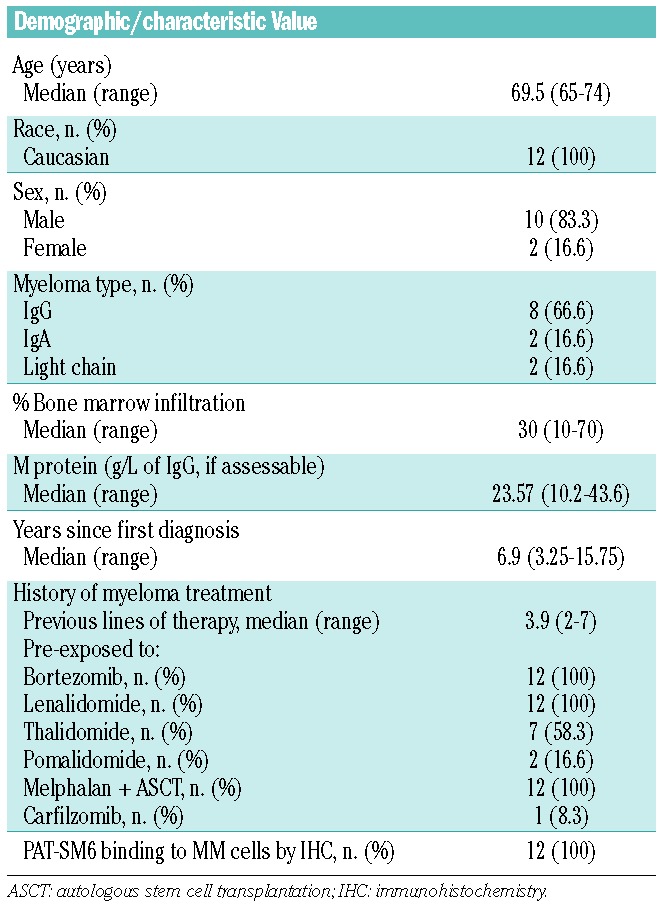
All subjects recruited into the study were Caucasian and had a median age of 69.5 years with a long history of MM (range, 3.25 to 15.75 years). They had been treated with multiple lines of therapy (range, 2–7; median 3.9 prior lines). Induction therapy, mobilization of autologous stem cells and high-dose melphalan with stem cell transplantation as well as maintenance were considered as one line of therapy.
As shown in Table 1 all patients had received lenalidomide and bortezomib and at least a single autologous stem cell transplant. Seven out of 12 (58.3%) patients had received thalidomide. In addition, carfilzomib was used in one patient, and pomalidomide was used in two of the 12 patients.
Relapse during or within 6 weeks after completion of a bortezomib- or lenalidomide-containing therapy was seen in three and four of the 12 patients, respectively (Online Supplementary Table S1). These patients were, therefore, refractory to novel agents.
Safety
All 12 subjects received the complete dose of PAT-SM6 administered intravenously via a volumetrically controlled infusion pump over a 90 min period, according to the protocol and are included in the safety analysis.
A total of 54 treatment-emergent adverse events (TEAE) were reported by the 12 subjects across the four dose cohorts, with all patients having at least one TEAE (100%). No dose-limiting toxicities were observed during the study and no deaths were reported. The maximum tolerated dose had not been reached at 6 mg/kg, the maximum dose used in this study.
Twenty-one TEAE out of the 54 reported were considered PAT-SM6-related by the investigators: seven out of 16 TEAE after the 0.3 mg/kg dose, five out of 11 after the 1 mg/kg dose, eight out of 20 TEAE after the 3 mg/kg dose and one out of seven TEAE after the administration of the 6 mg/kg dose of PAT-SM6.
As shown in Table 2, the most frequently reported TEAE were leukopenia and neutropenia. All events were of mild or moderate intensity and it was difficult to assess with certainty whether they were due to PAT-SM6 treatment or due to progression of the disease. Lymphopenia was not observed in the study.
Table 2.
Treatment emergent adverse events (TEAE).
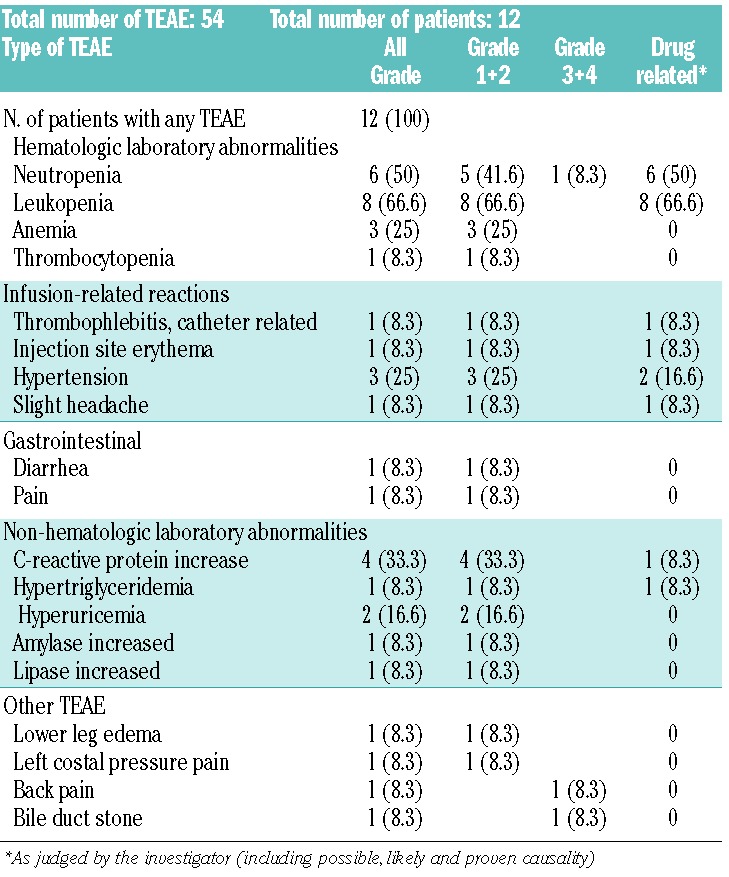
Other related adverse events reported included hypertension, infections, skin disorders and back pain. Increases in C-reactive protein and triglyceride levels were observed in some patients. The increases in C-reactive protein were mild and experienced by four patients (33.3%) and only one case was judged to be drug-related. Hyperuricemia, amylase and lipase increases were not drug related.
More than 80% of the TEAE were of mild to moderate intensity. Two patients (16.6%) experienced one serious TEAE each. One patient in the 0.3 mg/kg cohort reported acute back pain and one patient in the 3 mg/kg cohort reported a bile duct stone. Neither of the serious TEAE was related to the study medication. The acute back pain in the patient in the 0.3 mg/kg cohort was found to be due to a pre-existing bone lesion and progression of myeloma disease while the patient in the 3 mg/kg cohort was hospitalized due to suspected choledocholithiasis and stone extraction was performed.
Analysis and evaluation of clinical laboratory parameters (hematology, coagulation, biochemistry and urinalysis) as well as vital signs (heart and respiratory rate, blood pressure, ECG, etc.) indicated that repeated administration of 0.3, 1, 3 or 6 mg/kg PAT-SM6 did not result in significant changes in health. No subjects withdrew consent to participate in the study because of adverse events.
Pharmacokinetics
All patients had measurable plasma PAT-SM6 concentrations. The mean pharmacokinetic variables are listed in Table 3. There were three patients in each dose cohort and all subjects received four doses of PAT-SM6 (on days 1, 3, 8 and 10). Samples for pharmacokinetic analyses were taken pre-dose, 0.5 h after the start of the infusion, at the end of the infusion (1.5 h) and at 3 h, 6 h and 24 h on days 1 and 10 and pre-dose on days 3 and 8.
Table 3.
Summary of pharmacokinetic parameters.

As shown in Figure 2 and Table 3, the pharmacokinetic pattern indicates linearly dose-dependent increases in maximum serum concentrations (Cmax) of PAT-SM6, ranging from 4341 ± 548 ng/mL for the 0.3 mg/kg dose to 74740 ± 28135 ng/mL for the 6 mg/kg dose. Systemic exposure to the drug, demonstrated by the area under curve (AUCt) was in line with the Cmax and showed a similar linear behavior. The maximum serum concentration was reached at the end of the infusion. The serum concentration of PAT-SM6 then started to decrease at 3 h and 6 h after administration. There was minimal accumulation and no observable higher Cmax on continued dosing presumably due to the short half-life of about 7 h (Figure 2).
Figure 2.
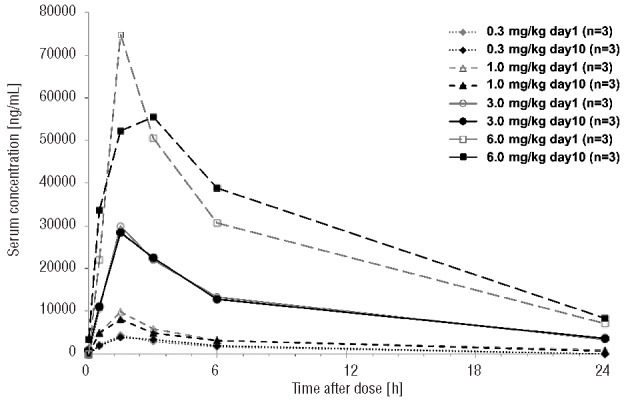
Pharmakokinetics: mean serum concentration profiles of PAT-SM6 for dose days 1 and 10 by dose level (linear). There is a minimal accumulation over the dosing period, with similar serum concentrations and pharmacokinetic parameters on day 1 and day 10. For the majority of subjects, the maximal concentration occurred at 1.5 h (end of infusion).
The volume of distribution ranged from 101±56 to 150±43 mL/kg in the 1 mg/kg and 6 mg/kg dose cohorts, respectively, while clearance ranged from 8.11±3.55 to 16.1±9.3mL/h/kg, suggesting little distribution outside the systemic circulation and slow clearance. Of note, some of these parameters were not calculable because of insufficient data after Tmax and large percentage AUC extrapolations. The parameters of half-life, volume of distribution and clearance were consistent across the dose levels (for the 1, 3 and 6 mg/kg doses) and between cycles.
Immunogenicity
All study subjects were screened for the development of human anti-human antibodies against PAT-SM6 (day 15 and end of trial) and no immunogenicity was observed.
Efficacy assessment
Efficacy was evaluated in terms of tumor response (complete response, very good partial response, partial response, stable disease, progressive disease) using the IMWG uniform response criteria for MM. The evaluations were performed at baseline, at day 29 and day 36. A summary of the findings of the clinical assessment is presented in Online Supplementary Table S1.
All patients showed progressive disease (>25% increase of M-protein) at study entry, in accordance with the inclusion criteria. At the end of the trial one-third (4/12) of the patients had stable disease (Figure 3) whereas the others had progressed. Because stable disease is not necessarily related to a clinical benefit, and can additionally be found in patients with slow/smoldering myeloma progression, the course of the four patients with stable disease was analyzed in detail.
Figure 3.
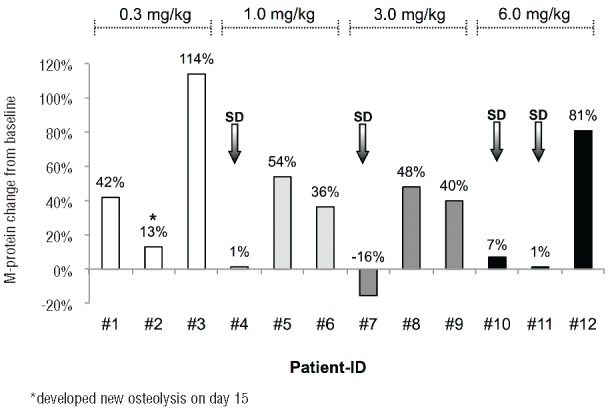
Changes in M-protein from baseline to end of the trial. Bars represent percentage changes in M-protein from baseline to day 36/end of the trial. Four patients experienced stable disease according to the IMWG criteria.
Patient #4 (1 mg/kg cohort) entered the study with cytogenetically classified high-risk disease [del (13q), +1q21] after having received five prior lines of therapy. The patient was refractory to novel agents including pomalidomide and bortezomib. The therapy-free interval prior to PAT-SM6 treatment was 1 month. During PAT-SM6 therapy no symptoms of active myeloma occurred. Salvage therapy was continued 1 week after the end of the study at the request of the patient.
Patient #7 (3 mg/kg cohort) participated in the trial after four lines of therapy over a 15-year history of myeloma. The therapy-free interval prior to PAT-SM6 treatment was 30 months. After PAT-SM6 treatment the patient remained therapy free for 4.6 months.
Patient #10 (6 mg/kg cohort) was heavily pretreated (6 lines of therapy), including tandem autologous stem cell transplantation as well as several polychemotherapeutic regimens. The therapy-free interval prior to PAT-SM6 treatment was 4 months. Salvage therapy was initiated 1 month after antibody treatment at the request of the patient.
Patient #11 (6 mg/kg cohort) received four lines of therapy prior to entering the study and was refractory to lenalidomide and thalidomide. The therapy-free interval prior to PAT-SM6 treatment was 12 months. After PAT-SM6 treatment the patient remained therapy free for 5.2 months.
PAT-SM6 target binding
Samples of bone marrow biopsies from all MM patients were assessed for the pattern of expression of the PAT-SM6 target structure by performing immunohistochemical staining. PAT-SM6 showed specific and homogeneous staining of MM cells in all patients, demonstrating that the target GRP78 was expressed on the MM cells of all the study patients. Representative samples of immunohistochemical stainings of bone marrow specimens are presented in Figure 4A. Flow cytometry analysis confirmed that PAT-SM6 bound to the target on the cell surface of MM cells obtained from bone marrow samples of the patients (see examples in Figure 4A).
Figure 4.
PAT-SM6 target binding (A) Immunohistochemical staining with PAT-SM6 on paraffin-fixed sections of MM patients and flow cytometry analysis on MM cells from bone marrow. Tumor biopsies from patients with MM were collected, fixed in formalin and embedded in paraffin. Positive control: anti-CD138; isotype control: unrelated human IgM. PAT-SM6 specifically stained multiple myeloma cells (magnification x 100). Images were captured using a Leica DM BL microscope, a Leica ICC HD digital camera and Leica LAS EZ V2.1.0 software. MM cells obtained from bone marrow were analyzed by flow cytometry for PAT-SM6 cell surface binding. PAT-SM6 displayed binding to the cell surface of MM cells. The isotype control (gray histogram) was unrelated human IgM antibody. (B) Detection of PAT-SM6 on circulating MM cells. Before and after dosing, patients’ blood was collected and circulating MM cells were purified using CD138 magnetic beads. PAT-SM6 binding was confirmed using an anti-idiotype antibody specific for PAT-SM6 (anti-ID) by confocal microscopy (Leica DMRE/ UV microscope). In the post-treatment sample, red stained MM cells indicate the presence of PAT-SM6. Anti-CD138 was used as a positive control for MM cells (green).
In vivo binding of PAT-SM6 to MM cells could be demonstrated in two patients who had few detectable circulating myeloma cells (<100 cells/mL) and gave informed consent to additional blood sampling. CD138-isolated MM cells were taken before and 120 min after PAT-SM6 treatment and stained with PAT-SM6 anti-idiotype antibody (anti-ID). MM cells from peripheral blood samples taken after PAT-SM6 treatment but not in pre-treatment blood samples showed antibody binding in an immunofluorescent microscopy analysis. CD138-positive cells were used as a positive control for MM cells (Figure 4B). The results show that PAT-SM6 antibody was able to detect and bind to the myeloma cells in patients’ blood.
Immune monitoring of all patients was conducted by measuring levels of various immune cell populations including T-cell subsets such as memory and activated CD4 and CD8 cells, γ/δ T cells, NK/NKT and T regulatory (Treg) cells (Online Supplementary Table S2). The levels of these cells in patients’ blood at day 0 of the trial (before PAT-SM6 treatment) were compared with levels measured at day 10. Increases of CD8-positive T cells and NK cells were observed in patients with stable disease. Results are presented in the Online Supplementary Data (Online Supplementary Figure S1).
Discussion
This single-center, dose-escalating study showed that PAT-SM6 had a favorable safety profile in the cohort of 12 patients with relapsed and refractory MM.
Safety assessments showed that repeated administration of 0.3 mg/kg, 1 mg/kg, 3 mg/kg and 6 mg/kg doses of PAT-SM6 were well tolerated. A maximum tolerated dose was not reached. Limited availability of the antibody product prevented inclusion of additional escalation dose cohorts.
Overall, no trends were observed between dose cohorts with regards to frequency, relationship, or severity of side effects. The most frequently reported TEAE were neutropenia and leukopenia which, at least in some patients, could have been due to disease progression. Only one injection site reaction was observed indicating that pre-medication with antihistaminic drugs (H1-blocker clemastine, H2-blocker ranitidine) was successful in preventing allergic reactions. There was no need for steroid administration throughout the study.
Pharmacokinetic analysis of 12 MM patients demonstrated apparent linear pharmacokinetics with a rapid distribution phase followed by a slower disposition phase and a half-life of about 7 h.
In comparison, IgG antibodies have a half-life of approximately 25 days depending on the IgG concentration in the circulation and saturation of the FcRn receptor responsible for preventing degradation of IgG antibodies.23 IgG, therefore, demonstrate concentration-dependent affinity homeostatic binding to targets and receptors. Although a similar Fc receptor binding mechanism may also be involved in IgM pharmacokinetics,24 we may postulate that, due to their pentameric structure, IgM demonstrate high avidity and may bind to targets and receptors much more strongly and be cleared more quickly from the circulation than monomeric affinity defined IgG.
The short half-life of approximately 7 h of PAT-SM6 was comparable to the average half-life in the few other IgM clinical studies available, ranging from approximately 1.76 h25 to 5 days.26
Although the parameters of half-life, volume of distribution and clearance were consistent across the increased doses used in this PAT-SM6 study, it remains to be investigated whether administration at higher doses would affect the general pharmacokinetic properties of PAT-SM6.
Using the IMWG response criteria, one third (33.3%) of the patients had stable disease with a course of four infusions of PAT-SM6 at various doses ranging from 1 to 6 mg/kg. These results are similar to those obtained with other antibodies under clinical development for the treatment of MM such as lucatumumab (anti-CD40) and elotuzumab (anti-CS1). Forty-three percent (12/28) of relapsed and refractory MM patients treated with lucatumumab (doses 1–6 mg/kg) responded with stable disease and one patient had a partial response.7 However, the maximum tolerated dose for lucatumumab was reached at 4.5 mg/kg, limiting the clinical benefit of this antibody when used as a single agent. Nine out of 35 patients (26.5%) treated with increasing doses of elotuzumab (0.5 – 20 mg/kg) responded with stable disease. Like PAT-SM6 and lucatumumab, this antibody was used as a single agent.6 Of note, response rates in patients with relapsed or refractory MM improved significantly when elotuzumab was combined with bortezomib (partial response rates ranged from 48% to 92%)27 or lenalidomide and dexamethasone.28 Overall, compared with chemotherapeutic agents, monoclonal antibody therapies appear to be associated with fewer side effects and have distinct mechanisms of action that make them more suitable and effective when combined with other anti-myeloma therapies, especially in patients with chemotherapy-resistant disease.29
PAT-SM6 targets a surface isoform of GRP78 protein that exists in a membrane-associated form in tumor cells but has not been found on the surface of healthy cells. Furthermore, Kern et al. demonstrated that a variety of bortezomib-resistant solid tumor cell lines were able to secrete high amounts of GRP78. Although the levels of GRP78 expressed by myeloma cells were not as high as those of cells of some solid tumors (prostate and colon), the addition of recombinant GRP78 was still able to confer bortezomib resistance to OPM-2 myeloma cells. Knockdown of GRP78 gene expression in tumor cells and immune-depletion of GRP78 protein from tumor cell supernatants restored bortezomib sensitivity in vitro.12 Further studies elucidating the ability of PAT-SM6 to deplete soluble GRP78 need to be performed.
In the course of the study interesting observations were made regarding immune mechanisms of PAT-SM6. Immunmonitoring indicated that PAT-SM6 might induce an immune response by stimulating and increasing the absolute number of CD8-positive and NK cells. Interestingly, such changes were observed mainly in patients who had experienced stable disease after treatment with PAT-SM6 and may indicate specific crosstalk between PAT-SM6 and T cells that warrants further investigation.
It has been postulated that IgM antibodies may be responsible for linking the innate and adaptive immune systems and that formation of antigen–IgM complexes could lead to sustained humoral as well as cell-mediated immune responses.30 The activation of T cells, and specifically CD8-positive and NK cells, has been demonstrated in vitro31–33 and in vivo34 to eliminate MM cells effectively.35 The ability of PAT-SM6 to increase NK cell numbers and their activation may play an important role in stabilization of relapsed-refractory MM disease and may be used as a surrogate marker for in vivo activity of PAT-SM6 in future trials.
Treatment of relapsed-refractory MM continues to present a therapeutic challenge, prompting a continued search for additional therapeutic options. Although this PAT-SM6 trial showed no objective responses according to IMWG criteria, the results are encouraging because they reflect in vivo activity in a difficult-to-treat population. Targeting GRP78, which is responsible for resistance in many cancers, highlights the prospective role of PAT-SM6 in combination with existing therapies to overcome tumor resistance. Furthermore, the favorable safety profile of PAT-SM6 makes it a likely candidate for possible synergistic results while maintaining low toxicity. Further studies with increased doses of PAT-SM6, longer therapy intervals and possibly inclusion of more patients with indolent/smoldering MM as well as studies combining PAT-SM6 with other MM drugs remain to be conducted in the future.
Acknowledgments
The authors would like to thank the patients and their families for their participation. We would also like to thank research nurses, physicians, technicians, and other staff at the study sites. Especially we thank Verena Pscheidl for her excellent work. The authors also thank Dr. Harald Rosenberger, Dr. Alexa Karsten, Dr. Sabrina Kraus and Dr. Cyrus Sayehli for their contributions.
Footnotes
The online version of this article has a Supplementary Appendix.
Authorship and Disclosures
Information on authorship, contributions, and financial & other disclosures was provided by the authors and is available with the online version of this article at www.haematologica.org.
References
- 1.Danylesko I, Beider K, Shimoni A, Nagler A. Monoclonal antibody-based immunotherapy for multiple myeloma. Immunotherapy. 2012;4(9):919–938. [DOI] [PubMed] [Google Scholar]
- 2.Yang J, Yi Q. Therapeutic monoclonal antibodies for multiple myeloma: an update and future perspectives. Am J Blood Res. 2011;1(1):22–33. [PMC free article] [PubMed] [Google Scholar]
- 3.Tai YT, Anderson KC. Antibody-based therapies in multiple myeloma. Bone Marrow Res. 2011;2011:924058. [DOI] [PMC free article] [PubMed] [Google Scholar]
- 4.Tai YT, Dillon M, Song W, et al. Anti-CS1 humanized monoclonal antibody HuLuc63 inhibits myeloma cell adhesion and induces antibody-dependent cellular cytotoxicity in the bone marrow milieu. Blood. 2008;112(4):1329–1337. [DOI] [PMC free article] [PubMed] [Google Scholar]
- 5.de Weers M, Tai YT, van der Veer MS, et al. Daratumumab, a novel therapeutic human CD38 monoclonal antibody, induces killing of multiple myeloma and other hematological tumors. J Immunol. 2011;186(3):1840–1848. [DOI] [PubMed] [Google Scholar]
- 6.Zonder JA, Mohrbacher AF, Singhal S, et al. A phase 1, multicenter, open-label, dose escalation study of elotuzumab in patients with advanced multiple myeloma. Blood. 2012;120(3):552–559. [DOI] [PMC free article] [PubMed] [Google Scholar]
- 7.Bensinger W, Maziarz RT, Jagannath S, et al. A phase 1 study of lucatumumab, a fully human anti-CD40 antagonist monoclonal antibody administered intravenously to patients with relapsed or refractory multiple myeloma. Br J Haematol. 2012;159(1): 58–66. [DOI] [PubMed] [Google Scholar]
- 8.Pohle T, Brändlein S, Ruoff N, Müller-Hermelink HK, Vollmers HP. Lipoptosis: tumor-specific cell death by antibody-induced intracellular lipid accumulation. Cancer Res. 2004;64(11):3900–3906. [DOI] [PubMed] [Google Scholar]
- 9.Rauschert N, Brändlein S, Holzinger E, Hensel F, Müller-Hermelink HK, Vollmers HP. A new tumor-specific variant of GRP78 as target for antibody-based therapy. Lab Invest. 2008;88(4):375–386. [DOI] [PubMed] [Google Scholar]
- 10.Ni M, Zhang Y, Lee AS. Beyond the endoplasmic reticulum: atypical GRP78 in cell viability, signalling and therapeutic targeting. Biochem J. 2011;434(2):181–188. [DOI] [PMC free article] [PubMed] [Google Scholar]
- 11.Ni M, Zhou H, Wey S, Baumeister P, Lee AS. Regulation of PERK signaling and leukemic cell survival by a novel cytosolic isoform of the UPR regulator GRP78/BiP. PloS One. 2009;4(8):e6868. [DOI] [PMC free article] [PubMed] [Google Scholar]
- 12.Kern J, Untergasser G, Zenzmaier C, et al. GRP-78 secreted by tumor cells blocks the antiangiogenic activity of bortezomib. Blood. 2009;114(18):3960–3967. [DOI] [PubMed] [Google Scholar]
- 13.Lee AS. Glucose-regulated proteins in cancer: molecular mechanisms and therapeutic potential. Nature reviews Cancer. 2014;14(4):263–276. [DOI] [PMC free article] [PubMed] [Google Scholar]
- 14.Ma XH, Piao SF, Dey S, et al. Targeting ER stress-induced autophagy overcomes BRAF inhibitor resistance in melanoma. J Clin Invest. 2014;124(3):1406–1417. [DOI] [PMC free article] [PubMed] [Google Scholar]
- 15.Delie F, Petignat P, Cohen M. GRP78 protein expression in ovarian cancer patients and perspectives for a drug-targeting approach. J Oncol. 2012;2012:468615. [DOI] [PMC free article] [PubMed] [Google Scholar]
- 16.Fu Y, Lee AS. Glucose regulated proteins in cancer progression, drug resistance and immunotherapy. Cancer Biol Ther. 2006;5(7):741–744. [DOI] [PubMed] [Google Scholar]
- 17.Rasche L, Duell J, Morgner C, et al. The natural human IgM antibody PAT-SM6 induces apoptosis in primary human multiple myeloma cells by targeting heat shock protein GRP78. PloS one. 2013;8(5):e63414. [DOI] [PMC free article] [PubMed] [Google Scholar]
- 18.Auner HW, Cenci S. Recent advances and future directions in targeting the secretory apparatus in multiple myeloma. Br J Haematol. 2015;168(1):14–25. [DOI] [PubMed] [Google Scholar]
- 19.Brändlein S, Rauschert N, Rasche L, et al. The human IgM antibody SAM-6 induces tumor-specific apoptosis with oxidized low-density lipoprotein. Mol Cancer Ther. 2007;6(1):326–333. [DOI] [PubMed] [Google Scholar]
- 20.Hensel F, Eckstein M, Rosenwald A, Brändlein S. Early development of PAT-SM6 for the treatment of melanoma. Melanoma Res. 2013;23(4):264–275. [DOI] [PubMed] [Google Scholar]
- 21.International Myeloma Working G. Criteria for the classification of monoclonal gammopathies, multiple myeloma and related disorders: a report of the International Myeloma Working Group. Br J Haematol. 2003;121(5):749–757. [PubMed] [Google Scholar]
- 22.Brändlein S, Pohle T, Ruoff N, Wozniak E, Müller-Hermelink H-K, Vollmers HP. Natural IgM antibodies and immunosurveillance mechanisms against epithelial cancer cells in humans. Cancer Res. 2003;63(22):7995–8005. [PubMed] [Google Scholar]
- 23.Masuda A, Yoshida M, Shiomi H, et al. Role of Fc receptors as a therapeutic target. Inflamm Allergy Drug Targets. 2009;8(1):80–86. [DOI] [PMC free article] [PubMed] [Google Scholar]
- 24.Kaveri SV, Silverman GJ, Bayry J. Natural IgM in immune equilibrium and harnessing their therapeutic potential. J Immunol. 2012;188(3):939–945. [DOI] [PMC free article] [PubMed] [Google Scholar]
- 25.Liedtke M, Twist CJ, Medeiros BC, et al. Phase I trial of a novel human monoclonal antibody mAb216 in patients with relapsed or refractory B-cell acute lymphoblastic leukemia. Haematologica. 2012; 97(1):30–37. [DOI] [PMC free article] [PubMed] [Google Scholar]
- 26.Ditzel H, Rasmussen JW, Erb K, et al. Tumor detection with 131I-labeled human monoclonal antibody COU-1 in patients with suspected colorectal carcinoma. Cancer Res. 1993;53(24):5920–5928. [PubMed] [Google Scholar]
- 27.Jakubowiak AJ, Benson DM, Bensinger W, et al. Phase I trial of anti-CS1 monoclonal antibody elotuzumab in combination with bortezomib in the treatment of relapsed/refractory multiple myeloma. J Clin Oncol. 2012;30(16):1960–1965. [DOI] [PMC free article] [PubMed] [Google Scholar]
- 28.Lonial S, Vij R, Harousseau JL, et al. Elotuzumab in combination with lenalidomide and low-dose dexamethasone in relapsed or refractory multiple myeloma. J Clin Oncol. 2012;30(16):1953–1959. [DOI] [PubMed] [Google Scholar]
- 29.Kay NE, Geyer SM, Call TG, et al. Combination chemoimmunotherapy with pentostatin, cyclophosphamide, and rituximab shows significant clinical activity with low accompanying toxicity in previously untreated B chronic lymphocytic leukemia. Blood. 2007;109(2):405–411. [DOI] [PMC free article] [PubMed] [Google Scholar]
- 30.Ilag LL. Immunoglobulin M as a vaccine adjuvant. Med Hypotheses. 2011;77(4):473–478. [DOI] [PubMed] [Google Scholar]
- 31.Sarkar S, Germeraad WT, Rouschop KM, et al. Hypoxia induced impairment of NK cell cytotoxicity against multiple myeloma can be overcome by IL-2 activation of the NK cells. PloS One. 2013;8(5):e64835. [DOI] [PMC free article] [PubMed] [Google Scholar]
- 32.Carbone E, Neri P, Mesuraca M, et al. HLA class I, NKG2D, and natural cytotoxicity receptors regulate multiple myeloma cell recognition by natural killer cells. Blood. 2005;105(1):251–258. [DOI] [PubMed] [Google Scholar]
- 33.Frohn C, Hoppner M, Schlenke P, Kirchner H, Koritke P, Luhm J. Anti-myeloma activity of natural killer lymphocytes. Br J Haematol. 2002;119(3):660–664. [DOI] [PubMed] [Google Scholar]
- 34.Benson DM, Jr, Hofmeister CC, Padmanabhan S, et al. A phase 1 trial of the anti-KIR antibody IPH2101 in patients with relapsed/refractory multiple myeloma. Blood. 2012;120(22):4324–4333. [DOI] [PMC free article] [PubMed] [Google Scholar]
- 35.Danylesko I, Beider K, Shimoni A, Nagler A. Novel strategies for immunotherapy in multiple myeloma: previous experience and future directions. Clin Dev Immunol. 2012;2012:753407. [DOI] [PMC free article] [PubMed] [Google Scholar]



